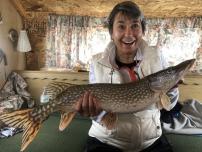
Photo by Sam Stukel/USFWS
Fishing tournaments rely on a strong population of aquatic species not only to make tournament fishing sustainable but to attract amateur anglers to the sport and to keep them engaged.
After all, a single tournament can bring in significant economic impact; the TBF High School Fishing World Finals and National Championship in Anderson, South Carolina consumed 10,488 hotel room nights and resulted in $2.5 million overall economic impact, making it one of SDM’s 2024 Champions of Economic Impact in Sports Tourism.
And let’s be clear. That was only one tournament. Across the U.S., across every species and across every fishing discipline, multitudinous tournaments are offered each year.
But tournament anglers start as amateurs, who cast lines into local streams. That means it behooves destinations to make sure those bodies of water stay stocked.
It might be of interest to event owners and destinations to know that NOAA – and specifically, NOAA Fisheries – plays a role in this.

According to NOAA’s official report, NOAA Fisheries manages 492 stocks or stock complexes in 45 fishery management plans. Stock assessments measure the impact of fishing on fish and shellfish stocks. They project harvest levels that maximize the number of fish that can be caught every year while preventing overfishing (removing too many fish), protecting the marine ecosystem and where necessary, rebuilding overfished (depleted) stocks.
While NOAA has successfully rebuilt 49 stocks over the last 20 years, rebuilding stocks to historical levels has become more challenging due to climate change and other factors. For example, waters off the northeastern United States are among the fastest warming in the world’s oceans, causing shifts in the distribution of many fish stocks and decreasing reproductive capacity. In Alaska, changes in ocean conditions and low reproduction are affecting population levels of some crab stocks such that conservation measures require a prohibition on fishing.
In other words, it’s not as easy as adding more fish. In fact, there are two types of restocking that are used, depending upon the ecosystem – and the goals of the local fisheries.
As one industry blog, The MeatEater, notes, restorative stocking is done to help return a native species of fish to a body of water where its population has been greatly decreased either by changing water conditions or by a competitive invasive species. “Restoration stocking is used when we want to reestablish a self-sustaining population after it has been lost for some reason and cannot be recolonized on its own,” Vermont Fisheries Biologist Lee Simard said.
The blog also noted, “While this may seem like an easy practice as the fish have previously lived in the waterway, there have often been changes to the environment in their absence that must be addressed before the fish can be reintroduced.”
For example, if the water conditions have changed or if the population of fish in the water is different, or if a predator has eliminated the previous population, the current conditions may not be habitable for the new fish – even if they are of a species that was once prevalent.
The second type of fish stocking, put-and-take, is primarily done to create fishing opportunities in bodies of water that don’t have any catchable numbers of wild fish. This can include air-dropping fish into high mountain lakes or stocking fish in sections of river that can’t otherwise support wild fish. It’s a great way for first-time anglers to get a catch; however, it may not be optimum for the waterway since, in many states, stocked fish often compete with wild fish that already live in that environment.
Of course, notes Scientific American, “Fish stocking has sometimes helped rebuild threatened native species, for instance, lake trout in the Great Lakes and brook trout in Great Smoky Mountains National Park.”

However, the article continued, “state and federal officials, together with some anglers, have begun to rethink the long infatuation with fish stocking, and in some cases they are working to unwind its destructive effects. In August 2016 the National Park Service approved a plan to remove stocked fish from 85 high-elevation lakes in California's Sequoia and Kings Canyon National Parks. Also [in 2016], Oregon removed limits on how many bass, walleye and other introduced game fish anglers can take in three rivers where those fish interfere with native species.”
Fish stocking, say conservationists and fish and game enthusiasts, can be a useful and helpful tool, both to attract new anglers and keep amateurs happy – and to try to preserve overall fishery health.
The article in Scientific American points out that California is one state that has made major changes in its stocking practices, stopping adding fish to hundreds of lake and moving to stock remaining lakes with only native species.
“Our mantra,” says to Roger Bloom, who manages inland fisheries for the California Department of Fish and Wildlife, “is to use the right fish in the right place at the right time and in the right numbers and to make sure we consider the benefits and effects at the ecosystem level.”

